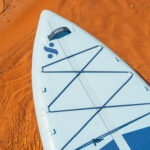Isle Switch Compact Review
Pros
- Exceptionally light! One of the lightest board we’ve reviewed this past year.
- Fabulously versatile; the Isle-Link deck fitting system means you can configure it however you want
- Super easy to carry and store; all those fantastic Compact things going for it
- Quick and easy to convert into kayak mode
- Incredibly stable for its size
- Surprisingly good tracking for such a wide shape
- Extremely good price for a Compact with the full kayak conversion kit included
Cons
- No action camera mount
- The miniature hand pump is nice but you’ll probably want a regular pump as well for normal use
- It’s not the fastest or most maneuverable board of this size (but still feels light and easy to paddle)
We always love a good Compact iSUP, so we were very excited to hear that Isle had moved their very popular Switch SUP/kayak hybrid all-rounder to the Compact format. We’re even more excited by what they’ve achieved, this new version absolutely rocks!

Compact paddle boards are a relatively new thing. I still get people looking at me sideways when I pull out a 10’6 inflatable SUP from a fairly tiny backpack. And I love traveling with compact boards even more.
However, as more of a paddle boarder than kayaker, I never expected to see a compact SUP / kayak hybrid board. Especially not one that performs well as both a paddle board and a kayak.
With the new Switch Compact, Isle has once again pleasantly surprised us with their ability to think outside the current industry box and create something that is not only unique but also highly versatile.
It’s a kayak, a SUP, and it fits into an incredibly small backpack that even my 12 year old won’t wine about carrying on his back.
Oh, and it’s a lot of fun to paddle on the water – either as a SUP or a kayak.
So we’ve got a lot to talk about in this review of the Isle Switch, but without giving too many spoilers, we can say for sure that we really like what Isle has done with the Switch. This is a very cool board, indeed.
We think the Isle Switch Compact would be a great SUP for paddlers who:
- Love the traveling and storage benefits of a Compact board
- Want a design that’s stable and user friendly yet fun and versatile too
- Love the idea of a board that comes ready to be effortlessly converted into kayak mode
- Want a board that’s super light and easy to carry.
Isle Switch Compact: Spec Sheet
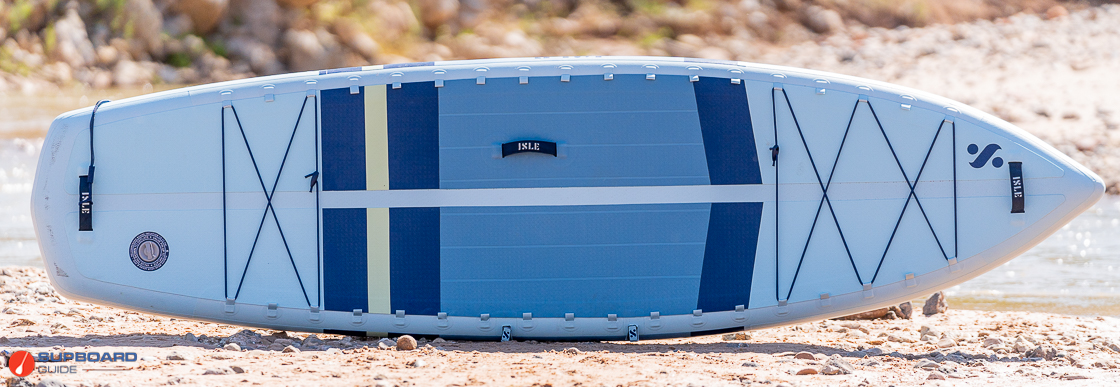
- Board Category:Compact all-rounder
- Listed Board Dimensions: 10’6 x 34” x 6”
- Measured Board Dimensions: 10’6 x 34” x 6”
- Listed Board Weight: 17 lbs
- Actual Board Weight (board only, not inflated): 18.6 lbs
- Listed Max Capacity: 220 lbs
- Recommended PSI: 15PSI +/- 2psi
- Fins: 2 x versa-flex click-fin
- Paddle: 4 piece carbon/nylon convertible SUP/kayak paddle
- Board Shell Construction Materials: Single layer PVC
- Drop-stitch type: Woven cross-threaded
- Price Range: $1095
- Warranty:
Performance Review of the Isle Switch Compact Stand Up Paddle Board
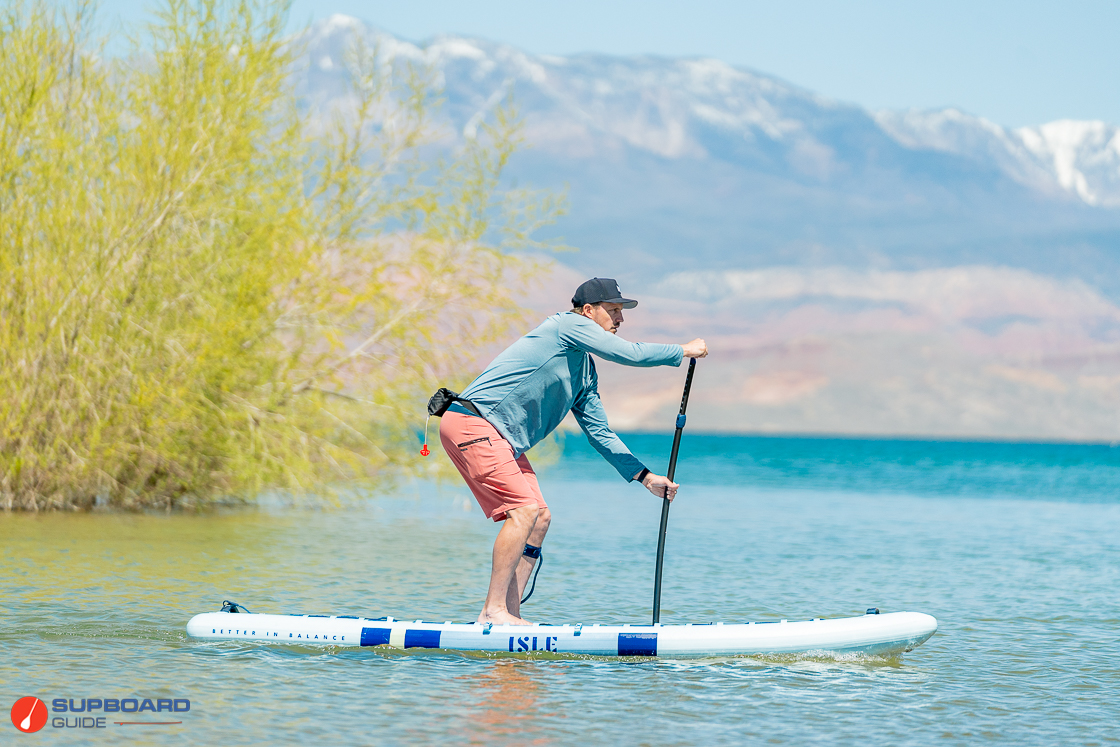


Overall Score: [9.5/10]
- Stability: 9.4/10
- Speed: 8.3/10
- Tracking: 8.9/10
- Maneuverability: 8.4/10
- Construction Quality: 9.6/10
- Features/Accessories: 9.8/10
Stability Rating: [9.4/10]
The previous version of the Switch, with its massive 11’6 x 35.5” plan shape, scored a whopping 9.8 in our Stability Rating. That’s as high as we go, pretty much. The board could carry an extraordinary amount of weight, and you really had to try very hard indeed to fall off.
But really; how much stability does a board actually need? For heavier riders or those wanting to carry a shedload of cargo, sure – stability matters. But that pigeonholes the board into something of a specialist design corner. Most people don’t need that much stability – especially because stability isn’t rent-free. Making a board super-stable and wide creates drag, which can really start to eat into the overall enjoyment factor. Your SUP still needs to feel fun and lively and responsive to paddle, otherwise why would you bother?
So we weren’t surprised to see that Isle have downsized the dimensions quite a bit. The move to the Compact format no doubt also played its part here; a smaller board weighs less and is easier to pack up anyway, but also, if you’re going to invest in creating a compact design you want it to have the widest possible appeal. So going smaller made sense in all sorts of ways.
Nevertheless, Isle have played it safe. Indeed, they’ve played a very intelligent game here, all round. 10’6 x 34” is undoubtedly considerably smaller than the previous version. But (not) coincidentally it’s the same dimensions as their Pioneer model, an already proven design with a lot of followers. The evidence is there that this size of board makes a lot of people happy. It’s still seriously stable, but it’s small enough to keep that fun factor high. On top of that, Isle have given themselves a bit more insurance by pumping up the tail width on the Switch even further. It’s considerably wider than the Pioneer tail, racking up that overall stability factor a notch or two higher still. Yes, it has reduced the top speed slightly, but nobody is buying these boards to win races.
So, while, yes the stability and weight carrying ability has definitely been reduced over the original Switch model, it’s still pretty damn high. The Switch Compact performs extremely well in terms of both primary and secondary stability. It’s also still more than stable enough to function extremely well and easily in its kayak mode.
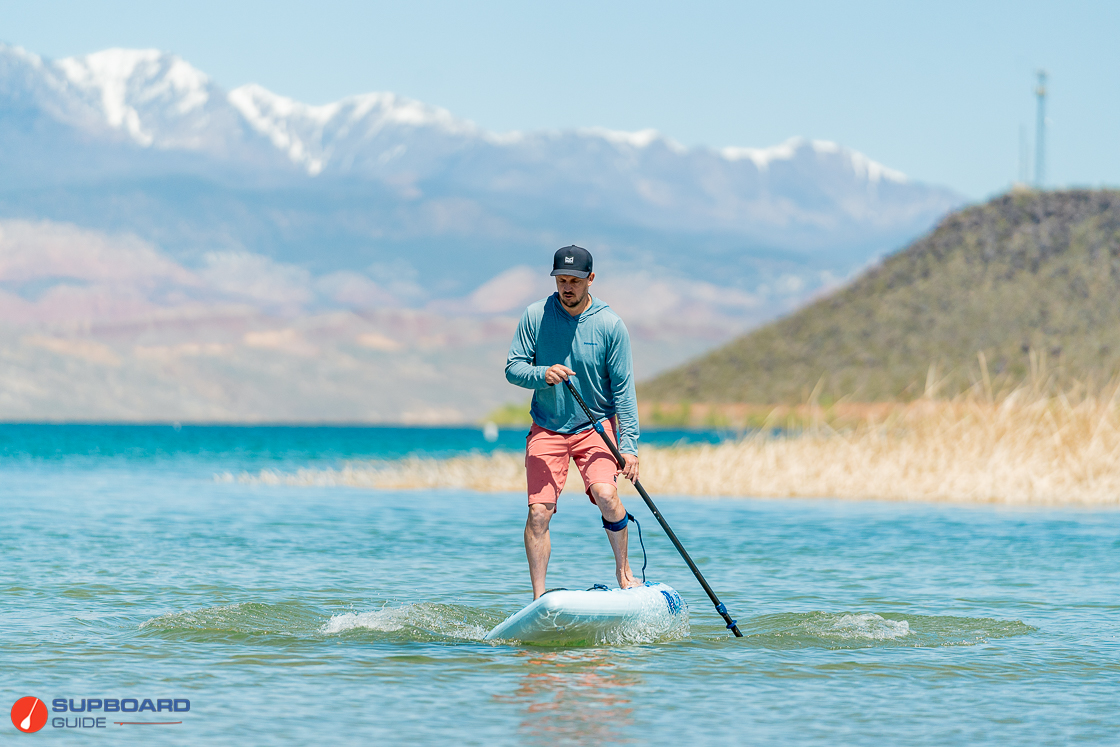
Speed Test: 8.3/10
| Board | |
| Top Sprint Speed: | 4.15 MPH |
| Average Cruising Speed: | 5.1 MPH |
To obtain our speed test results, we use a Speed Coach Sup 2. This gives us accurate readings on how fast we are paddling and our current stroke rates. For the top sprint speed, we paddle as hard as we can for approximately 10-15 seconds and then record our average speed. For the casual test, we paddle at 35-40 strokes per minute for approximately 30-60 seconds and record the average speed.
If you want to make a paddleboard fast, you give it a long waterline (longer boards are always faster), and try to reduce the drag by getting rid of as much width as possible. The Isle Explorer Pro 14’ demonstrates this very nicely, at 14’ long and 31” wide – an entirely different shape to the 10’6 length and 34” width of the Isle Switch Compact. So we aren’t ever approaching a 10’6 x 34” board expecting to find a race winner. Especially as in this particular case there are a few other factors that also work against speed. The super wide tail on this board increases the drag factor, and if that wasn’t enough, the toed-in twin fins put the brakes on yet further. So we weren’t anticipating an incredible turn of pace from this board.
However, we were actually pleasantly surprised. Board speed is an interesting thing because it’s both absolute and perceived. Board A may be faster than board B in absolute terms, but board B may still feel faster. The worst case scenario is when a board is slow, and feels it, too. The paddling experience is dull and sedentary; the board just has no interest in going fast.
Fortunately, the Switch Compact absolutely doesn’t suffer from this – while it is certainly slower than the similarly-sized Pioneer 3 and doesn’t glide through the water with quite the same ease, it still feels reasonably lively and fun to paddle, largely because it’s so incredibly light. It’s much easier to keep a board moving when it’s not heavy, and they don’t come much lighter than this Isle Switch Compact. You notice it too when you stop paddling – despite all that drag from the width the board still coasts a surprisingly good distance before drifting to a halt.
So, while it’s not the quickest, it absolutely doesn’t feel disadvantaged in this respect.
Tracking: 8.9/10


Short and wide boards are traditionally not that great at tracking. Width in particular can be an issue; not just in terms of how the board moves in the water, but also – as can be seen in the picture above – it’s very difficult to get your paddle vertically down into the water on a wider board, which in itself makes it that bit harder to hold a straight course.
However, Isle have done some clever things to keep the board on track. That super wide tail puts a huge amount of width in the rear half of the board, which really reduces the tendency to turn while paddling, and the sharply pointed nose also helps too. Plus which, the slightly toed-in twin fin configuration also contributes significantly to keeping the board on course.
Overall, we found that the tracking was very acceptable for a board of this style. We could get a good 6-7 normal paddle strokes in before the board started to veer noticeably.
Maneuverability: 8.4/10


A relatively short and wide board like the Isle Switch should be easy to turn. However, we found it just a bit less willing to respond to paddle steering strokes than the similarly-sized Pioneer 3. This is for the same reasons that make the Isle Switch Compact outperform the Pioneer in the tracking department – its twin fin configuration is working doubly hard to keep the board on track compared to the central single fin featured on the Pioneer 3. The wider tail of the Switch Compact is also working to resist changes in direction. (The diamond tail definitely helps in this respect, but there’s no getting away from the fact that this is one wide-tailed board!)
However, if your paddling technique is up to walking back on the board to get the nose up and pivot that turn, then in this respect the Switch Compact actually outperforms the Pioneer 3 as its tail is even wider and more user-friendly for getting right back onto. We can’t fairly factor this into our maneuverability scores though, since of course any board can be turned quickly using a tail-sink pivot turn if you get enough of the nose out of the water. So it’s not a fair indication of whether a board is naturally maneuverable or not. But it’s still a relevant consideration when discussing maneuverability.
Once again, that weight factor also comes into play. A lighter board feels easier to turn! And this makes up for a lot of the more locked-in feel of the Switch Compact. It might take an extra stroke or two to get the arc of turn you want, but overall it can be turned without much difficulty using any standard paddle turning techniques. And it’d certainly be a great board for learning to do step-back pivot turns on, too!
Construction Quality: 9.6/10


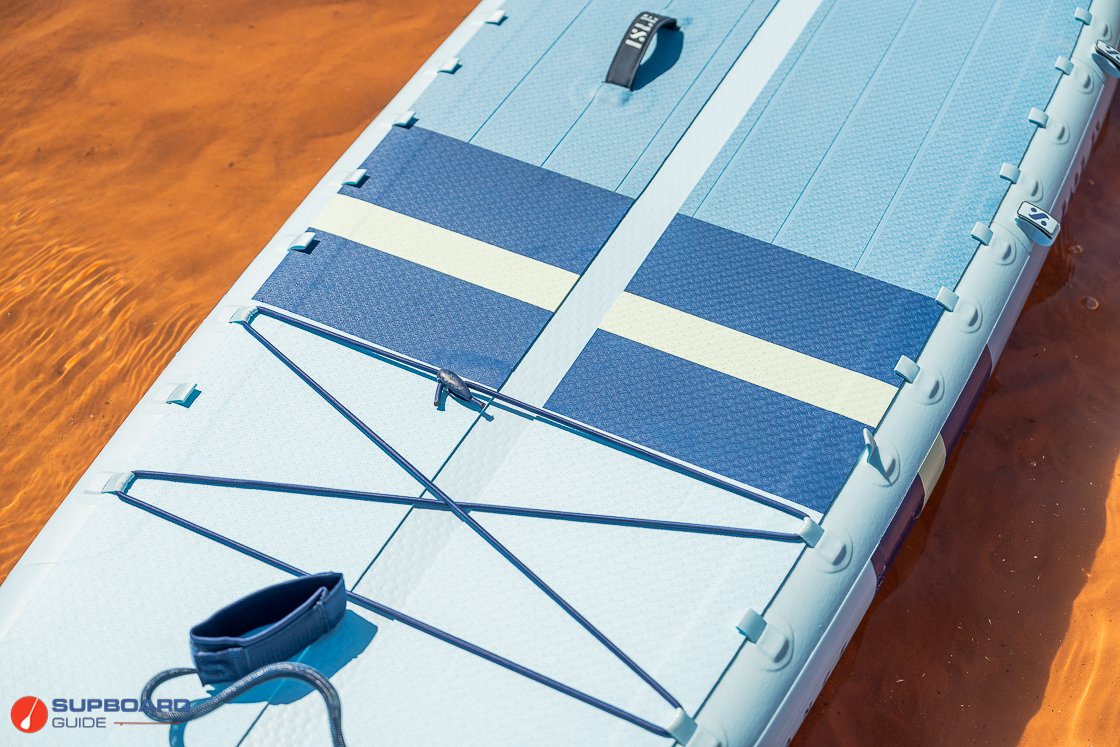
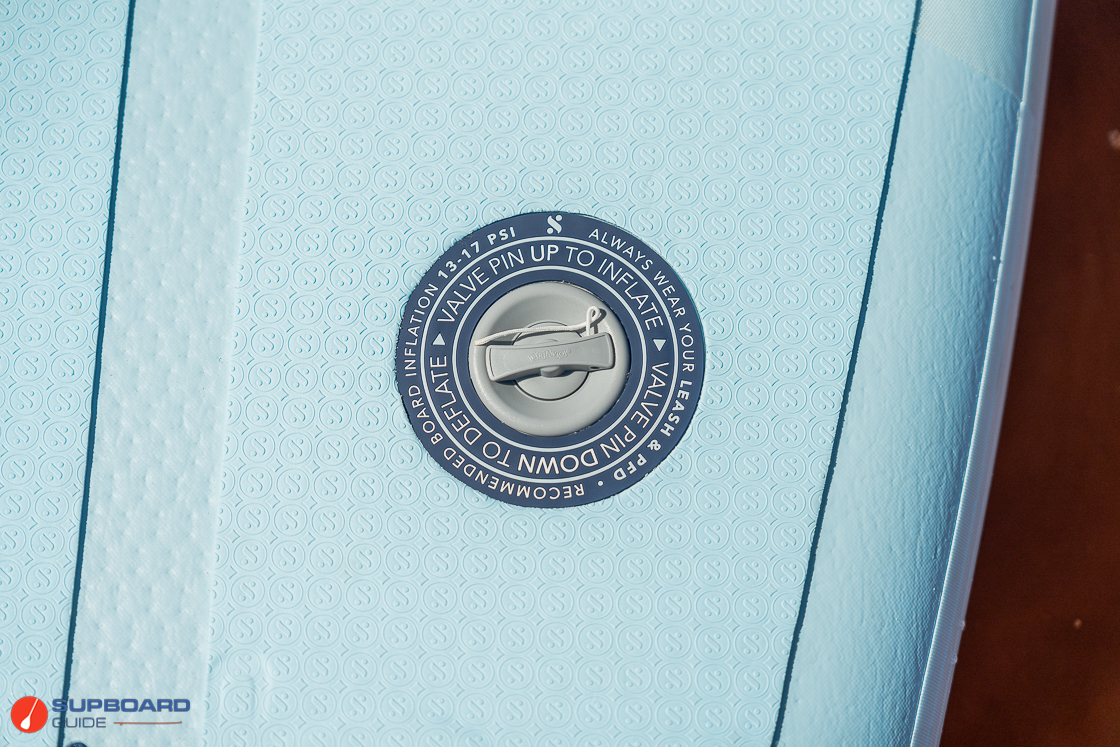
The big difference between this latest version of the Isle Switch and its predecessor is in the construction. The 2024 model features a single layer skin, with the PVC layer fused directly to the dropstitch substrate. By doing this they’ve reduced the weight to an astonishing 18.6 lbs, which of course really helps with the whole Compact concept, making it even lighter to carry.
The normal trade-off when moving to a single layer construction, as we’ve discussed at length in the other Isle 2024 reviews (check out the Pioneer and Explorer write-ups) is a loss of rigidity in the board. However, Isle have managed to maintain the board stiffness with the use of their ‘parabolic rail stringers’, an extra layer of PVC on the top and bottom of each rail which locks a whole lot of rigidity into the design. These, coupled with the welded seam construction and woven dropstitch now used by Isle, really give the board a solid durable feel, despite being so impressively light.
Board Stiffness:
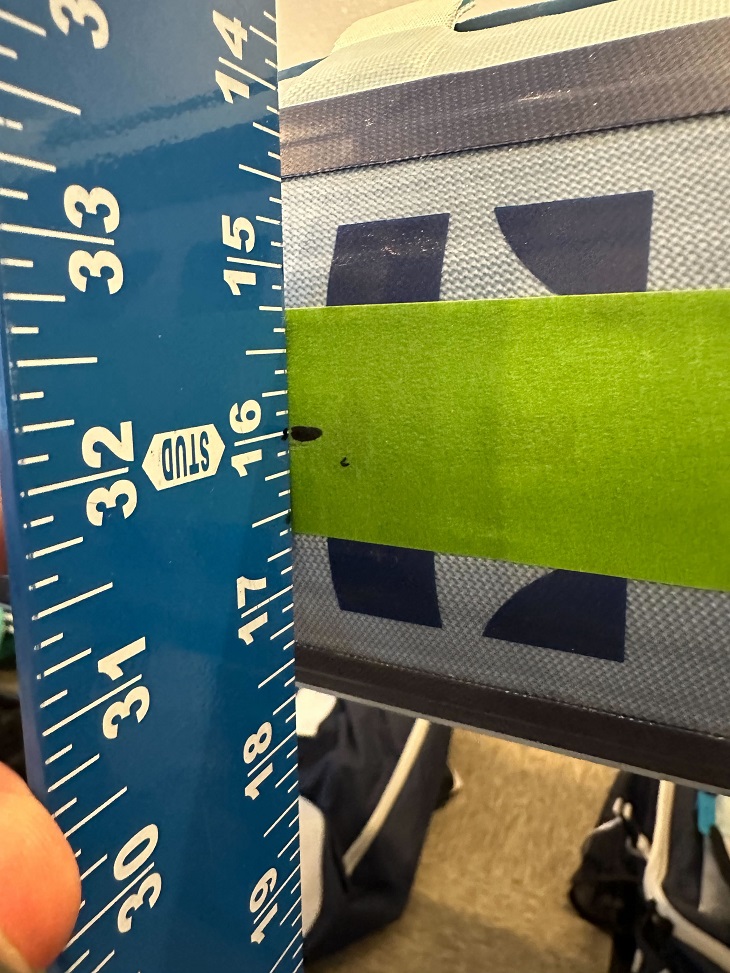

Stiffness Test: 1.125” Bend
As discussed in the previous section, the Switch Compact utilizes a single layer construction, compared to the double layer (2 layers glued together) or Fusion (2 layers fused together without glue) construction processes used by most other brands nowadays. Single layer is lighter but inevitably slightly less rigid. However, as can be seen from our bend test, the board still supports weight very well, thanks to the ‘exoskeleton’ created by the parabolic PVC stringers on each rail. The substantial width throughout also plays a part in creating a stable platform, indeed this is why the Switch Compact shows even less bend than the similarly-sized Isle Pioneer 3 which utilizes the same construction. The wider tail on the Switch Compact just puts that extra bit of rigidity into the system.
The reality is that in normal paddling on this board, you don’t actually feel much flex at all, until you really try and paddle it hard and fast. For normal paddling it feels as rigid as any other board.
To ascertain the rigidity of each board we review, we use our own specific laboratory bend test process. The board is inflated to its maximum recommended PSI and then placed across two sawhorses positioned exactly 7 feet apart. We then measure the distance from the middle of the board to the floor. Then, we place a 150 lb weight on the middle top of the SUP, and measure the distance to the floor again. The difference between the two measurements shows the deflection, or ‘sag’, that the board has experienced due to the added weight. We have been reviewing the stiffness of boards using this technique since 2021 and while it isn’t an exact replication of the weight distortion that occurs when a rider stands on a SUP board in the water, it still gives a very useful comparative tool in determining the stiffness of the board’s construction process.
Features/Accessory Review: [9.8/10]
Features:

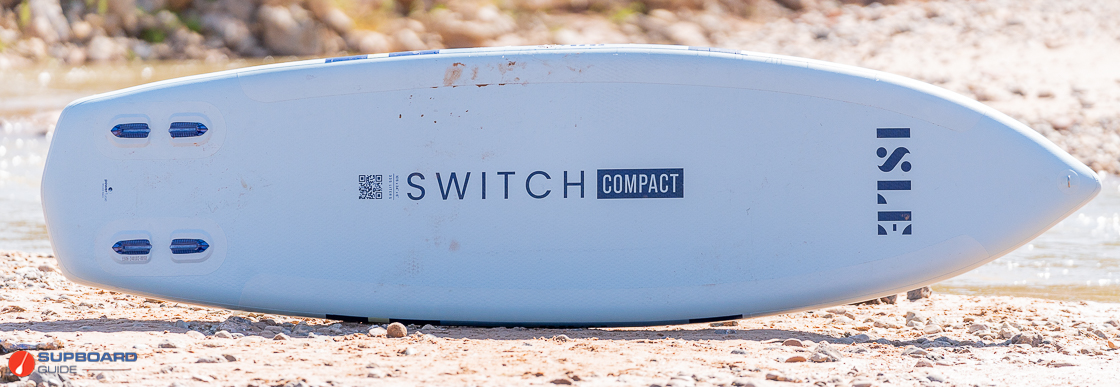
The Isle Switch Compact has been given the same features upgrade as the other third generation boards in the Isle range, and we’re big fans of what they’ve done to their boards. The Switch Compact features a full length deckpad, split in the middle to allow the board to be folded. The Isle-Link system of 18 webbing loops along each side allows you to easily position the front and back bungees, and other accessories such as the kayak seat and footrest, wherever you like on the board.
The central carrying handle is low profile and will lay flat underfoot should you stand on it, or wish to use the board in yoga/exercise mode. (And it should be said that with the board being so light, you really don’t need a more padded handle for carrying it!)
The only thing obviously missing from the deck in comparison to other multi-function boards like this is an action camera mount. Fortunately, there are plenty of good stick-on versions available to remedy this should it be of importance to you.
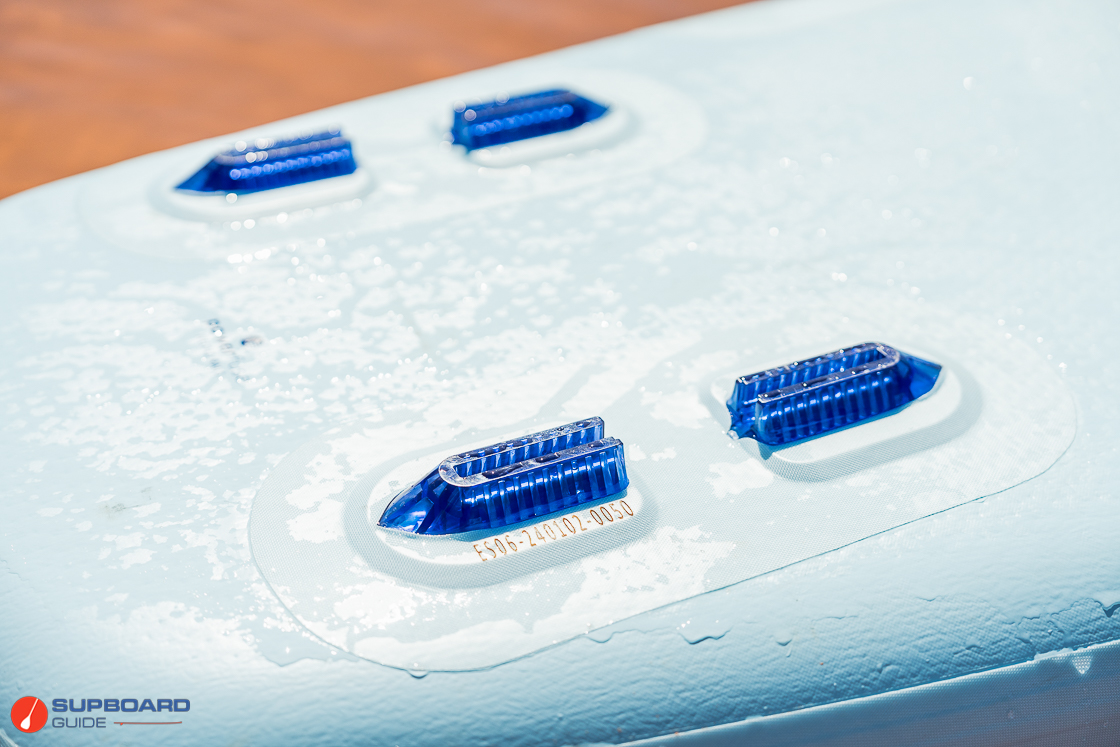

On the underside of the board we find two fin boxes, both of the new Isle split style, to make the board easier to roll up. The 7” Versa flex fins easily click into the fin boxes, which are of the US box style and long enough that you could utilize other US-compatible fins with the board.
On the underside of the nose of the board, is a D ring for towing.

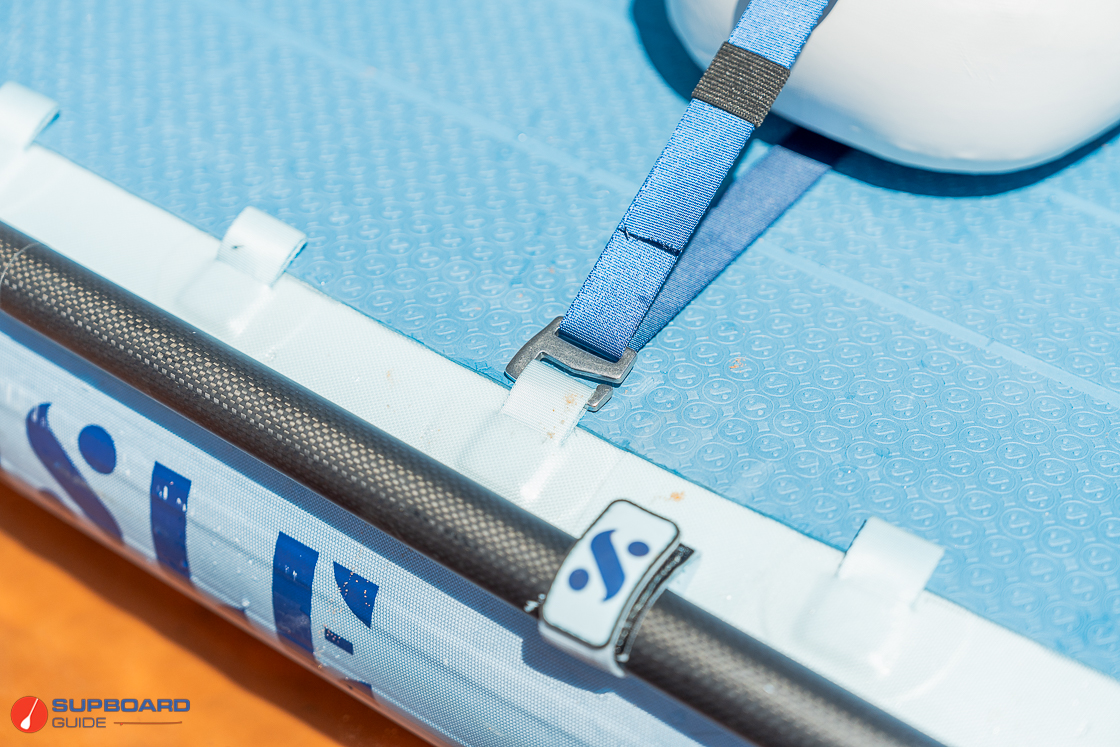
Included Accessories:

Isle has clearly given a lot of thought to the development of the whole Compact concept. The miniaturized hand pump is a great idea – this is where other Compact board packages tend to suffer; having to carry a normal sized pump as well as the reduced size board. Isle have produced a shortened version of their Totora double action pump, with the removable base making it easier for packing away. It actually works OK but definitely takes a few minutes longer to inflate the board with, so for normal use you’re going to want a regular pump or electric pump for sure, but it’s undoubtedly a great weight/space saving solution if you’re carrying your compact board any significant distance.
The SUP/kayak convertible paddle is essentially a 4 piece paddle, with the option for either a SUP handle or the second blade as the top section. The paddle allows for a decent amount of length adjustment, and we were impressed by its performance on the water; it felt light and pleasantly stiff and functional, and the clips where sections connect together aren’t where you want to put your hands. It’s as good a compact paddle as we’ve encountered so far, and comes supplied in its own mesh bag.
The waterproof dry bag is a useful extra and a nice touch.
Finally, the backpack itself is very much worthy of praise. It’s light, functional and well thought out. It easily has enough room for the board, paddle and pump plus a bit more, and there are large webbing pockets on the sides for water bottles or whatever else you might want to carry along. The padded shoulder straps can be stowed internally if you’re taking the bag onto a plane.


Summary Review of the Isle Switch Compact

The Isle Switch Compact is without doubt an excellent and welcome addition to the Compact iSUP market. It’s a really well thought out product, and Isle’s Isle-Switch accessory mounting system really raises the bar when it comes to building versatility into a board. Indeed, as far as we know it’s the first purpose-built compact SUP/kayak hybrid on the market – great work Isle!
Having the Switch Compact and the Pioneer 3 in the Isle range – two very similar boards in terms of size and role – gives the buyer wanting a super stable user friendly all rounder an interesting dilemma – which to get?
In terms of performance, the Pioneer is a little bit quicker and more maneuverable in feel, while the Switch Compact tracks a little better and has a bit more stability to offer. So it’s actually a really close race.
However, there is of course a significant price difference. But this is almost completely canceled out if you’re wanting the kayak conversion aspect. The cost of the kayak upgrades (seat, footrest and paddle) which come as standard with the Switch but you’d need to buy as additional accessories for the Pioneer, bring the prices almost back to parity. And you get those other bonuses of the Compact construction; the smaller package and easier carrying.
To conclude then, the Isle Switch Compact is hands-down our favorite SUP/kayak compact right now, and the package will take some beating for anyone wanting a really fun, user-friendly versatile all rounder for traveling with. Way to go Isle!
Happy paddling! We hope you enjoyed this review of the Isle Switch Compact. If you have any questions or comments please leave us a comment below!
SupBoardGuide
Latest posts by SupBoardGuide (see all)
- Best Paddle Boards for Beginners, 2025 - July 3, 2025
- Hala Radito Whitewater iSUP Review – 2025 - June 27, 2025
- Hala Atcha 96 Whitewater iSUP Review – 2025 - June 16, 2025


